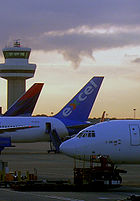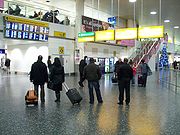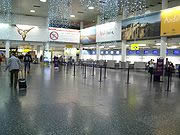Gatwick Airport cars

 |
|---|
Whether it is business or leisure Prestige Airport Cars can ensure it’s a pleasureable experience. We check and confirm the arrival time of your flight and our experienced drivers will meet you in arrivals and assist you with your luggage before taking you off in comfort to your required destination. Saving you money and our rates are one of the most competitive in the industry.
Our drivers are always ranked at Gatwick airport- available 24/7. We operate nationally whether you are travelling from Manchester to Gatwick or from Glasgow to Gatwick. Prestige Airport Cars is one of the most competitively priced London Airport transfer services for long distance Private Hire as well as those shorter trips into the City.
 Book online or call one of our friendly customer service agents, give them the details of your transport requirements and we’ll do the rest. 0208 908 1551 . (None UK - Call +44 208 908 1551 ).
Book online or call one of our friendly customer service agents, give them the details of your transport requirements and we’ll do the rest. 0208 908 1551 . (None UK - Call +44 208 908 1551 ).
Gatwick Airport Information
(Courtesy of wikipedia) - Gatwick Airport Map (below).
 London Gatwick Airport is London's second largest international airport and second busiest in the United Kingdom after Heathrow. In 2008, it was the world's 28th-busiest airport in terms of passenger numbers and 9th busiest in terms of international passengers. It is the world's busiest single-runway international airport.
London Gatwick Airport is London's second largest international airport and second busiest in the United Kingdom after Heathrow. In 2008, it was the world's 28th-busiest airport in terms of passenger numbers and 9th busiest in terms of international passengers. It is the world's busiest single-runway international airport.
Gatwick is 5 km (3.1 mi) north of central Crawley, West Sussex, 45.7 km (28.4 mi) south of London. Gatwick is owned and operated by BAA, which owns and operates six other British airports, and is itself owned by an international consortium led by the Spanish Ferrovial Group.
Passenger numbers peaked in 2007 when the airport handled over 35 million passengers for the first time, however this total reduced by 2.9% in 2008 with 34,205,887 passengers using Gatwick and 263,653 aircraft movements recorded.
In 2008, Gatwick celebrated 50 years - Queen Elizabeth II opened the airport on 9 June 1958.
Charter airlines generally do not operate from Heathrow and use Gatwick as a base for London and the South East. From 1978 to 2008, many flights to and from the US used Gatwick because of Heathrow restrictions implemented in the Bermuda II agreement between the UK and the US.(As of mid-2009, Delta Air Lines and US Airways are the only US carriers to continue serving Gatwick from the US.) The airport is a base for scheduled operators Aer Lingus, British Airways (BA), EasyJet and Virgin Atlantic. The airport is also a base for charter airlines including Monarch Airlines, Thomas Cook Airlines and Thomson Airways.
London Gatwick has a Civil Aviation Authority (CAA) Public Use Aerodrome Licence (Number P528) that allows flights for the public transport of passengers or for flying instruction.
On 17 September 2008, BAA said it would sell Gatwick following a report by the Competition Commission into BAA's dominance, especially in London and the South East. The airport has been valued at £1.8 billion by regulators.
Facilities
 Gatwick Airport has two terminals, North and South. Both have shops and restaurants landside and airside. Disabled passengers can travel through all areas. There are facilities for baby changing and feeding, and play areas and video games for children. Business travellers have lounges offering business facilities. There is a conference and business centre. The airport and area has hotels from executive to a capsule hotel.
Gatwick Airport has two terminals, North and South. Both have shops and restaurants landside and airside. Disabled passengers can travel through all areas. There are facilities for baby changing and feeding, and play areas and video games for children. Business travellers have lounges offering business facilities. There is a conference and business centre. The airport and area has hotels from executive to a capsule hotel.
South Terminal zone A check-in concourse
The airport has Anglican, Catholic and Free Church Chaplains. There is a multi-faith prayer room and counselling room in each terminal. A daily service is led by one of the chaplains. The prayer room is open to all faiths.
Major airlines
BA and EasyJet are Gatwick's two dominant resident airlines. In late 2007 BA and Easyjet accounted for 25% and 17% of Gatwick's slots. The latter's share of slots subsequently rose to 24% as a result of its takeover of BA franchise carrier GB Airways, which accounted for 7% of slots (late 2007). The acquisition of GB Airways in March 2008 resulted in EasyJet becoming Gatwick's biggest short-haul operator accounting for 29% of short-haul passengers (ahead of BA's 23%)[37] and Gatwick's largest airline overall, with flights to 62 domestic and European destinations (at April 2008). As of summer 2009, EasyJet has further reinforced its positions as Gatwick's leading airline by increasing the number of destinations served from the airport to 72. Gatwick is the airline's largest base.
Since then, airlines have started down-sizing transatlantic operations due to the new EU-US Open Skies Agreement. Continental Airlines is the second transatlantic carrier - after American Airlines - to pull out of Gatwick altogether, following its decision to transfer its seasonal Cleveland service to Heathrow from 3 May 2009. The slots vacated by these moves as well as by the collapse of Zoom, XL Airways UK and Sterling were taken by EasyJet, Flybe, Norwegian Air Shuttle and Ryanair.
By late 2008, EasyJet's share of Gatwick slots had grown to about 26%, while Flybe had become Gatwick's third-largest slot-holder accounting for 9% of the airport's slots, as well as its fastest-growing airline. As per the CAA's April/May 2009 passenger statistics, more UK domestic passengers flying to and from London Gatwick during April 2009 chose Flybe than any other airline.
From a peak of 40% in 2001, BA's share of Gatwick slots will have declined by 50% to 20% by summer 2009.
Changing character of airport
According to the evidence Flybe submitted at a Competition Commission hearing into BAA's market dominance at the beginning of 2008, Gatwick's dynamics were changing rapidly as a result of recent changes in its traffic pattern. These were likely to transform the airport from a secondary intercontinental airline hub into a predominantly European and domestic operation feeding London and specifically the south London market.
Operations
 Gatwick operates as a single runway airport. Strictly speaking it has two runways, however, the northern runway (08L/26R) can only be used when the main runway (08R/26L) is out of use, for example because of maintenance or an accident. The runways cannot be used at the same time because there is insufficient separation between them, and during normal operation the northern runway is used as a carway. It can take 15 minutes to change from one to the other.
Gatwick operates as a single runway airport. Strictly speaking it has two runways, however, the northern runway (08L/26R) can only be used when the main runway (08R/26L) is out of use, for example because of maintenance or an accident. The runways cannot be used at the same time because there is insufficient separation between them, and during normal operation the northern runway is used as a carway. It can take 15 minutes to change from one to the other.
The main runway operates with a Category III Instrument Landing System. The northern runway does not have an Instrument Landing System and, when it is in use, arriving aircraft use a combination of Distance Measuring Equipment and assistance from the approach controller using surveillance radar, or where equipped and subject to operator approval, an RNAV (GNSS) Approach, which is also available for the main runway. On all runways, considerable use is made of continuous descent approach to minimise environmental effects of incoming aircraft, particularly at night.
Night flights are subject to restrictions. Between 11pm and 7am the noisiest aircraft (rated QC/8 and QC/16) may not operate. In addition, between 11.30pm and 6am (the night quota period) there are three limits:
* An overall limit on the number of flights;
* A Quota Count system which limits the total of noise permitted, but allows operators to choose to operate fewer noisy aircraft or a greater number of quieter planes;
* QC/4 aircraft may not operate at night.
Transport
Gatwick has set the objective that 40% of passengers should be using public transport by the time the annual throughput reaches 40 million (estimated in 2015), from the 2006 figure of 35.3%.
The airport is accessed by a motorway spur road at junction 9A of the M23, which links to the main M23 motorway a mile (1.5 km) east at junction 9. The M23 connects with London's orbital motorway. The M25, 9 miles (14 km) north, gives access to Greater London and the South East. The M23 is the main route by traffic to reach the airport. Gatwick is accessed locally by the A23, which serves Horley and Redhill to the north and Crawley and Brighton to the south. The A217 provides access northwards to the local town of Reigate.
The airport has long and short-stay car parks - at the airport and off-site - although these are often full in summer. Local planning restrictions limit car parking at and around Gatwick.
Gatwick Airport railway station
The Gatwick Airport railway station is next to South Terminal and provides connections along the Brighton Main Line to London Victoria and London Bridge stations, as well as Brighton and Worthing to the south. Gatwick Express to Victoria is the best-known service from the station, but other companies, including Southern, First Capital Connect and First Great Western, use the station. First Capital Connect provide direct trains to Luton Airport and First Great Western trains provide a direct rail link with Reading and connections with Oxford and the West.
Foot passengers can reach Heathrow by a X26 Express Bus from bus outside East Croydon station.
National Express Coaches operates coaches to Heathrow Airport and Stansted Airport, as well as cities and towns throughout the region.
Oxford Bus Company operate direct services to Oxford. EasyBus operates minicoaches from Gatwick to London Victoria. (National Express Dot2Dot used to operate a service to central London, but this ceased in 2008.)
Local buses connect North and South terminals with Crawley, Horley, Redhill, Horsham and other destinations. Services are offered by Metrobus and Fastway, a guided bus rapid transit system which was the first of its kind to be constructed outside a major city.
There are at least two sets of stairs for foot-passengers to leave South Terminal to ground-level (near the cycle route) from Zone L and the train-station area (steps are labelled Exit Q and Exit P on the ground). These allow access to bus stops for local services.



